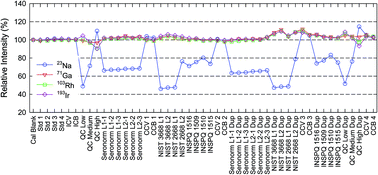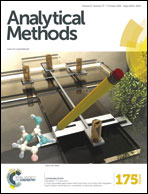Determination of trace elements in human urine by ICP-MS using sodium chloride as a matrix-matching component in calibration
Abstract
An inductively coupled plasma mass spectrometry (ICP-MS) method was developed for the simultaneous determination of the following thirteen trace elements in human urine: Cr, Mn, Co, As, Se, Sr, Mo, Cd, Sb, Hg, Tl, Pb, and U. An Agilent 7700x ICP-MS fitted with a helium mode collision cell was used, along with an integrated sample introduction system for flow injection analysis. An optimal helium flow rate of 5.5 mL min−1 through the collision cell was determined based on background levels, analyte-to-background signal ratios, and analytical precisions. The sample diluent was added with n-butanol as a carbon source to enhance analytical sensitivity, which yielded higher signal intensities than methanol or ethanol. The basic diluent prepared with 4% (v/v) n-butanol, 1% (w/v) ammonium hydroxide, 0.1% (w/v) ethylenediaminetetraacetic acid (H4EDTA), and 0.05% Triton X-100, also demonstrated excellent washout efficiency, requiring only <60 s of rinse time to minimize the Hg memory effect. Sodium chloride (0.95%, w/v) was added to intermediate calibration standards as a matrix-matching component in order to equalize analyte signal suppression caused by inorganic urine components. When both calibration standards and urine specimens were diluted 1 : 10 with the diluent, no considerable variability was observed in internal standard signals throughout the analyses, in spite of a wide range of Na content in urine specimens. Potential Mo oxide interferences on Cd signals were taken into account and minimized with empirically estimated correction factors. Analysis of standard reference materials as well as proficiency testing specimens yielded accuracies of 100 ± 10% for most certified/reference values. Long-term precision of the method was also routinely monitored with internal quality control urine specimens, and after a period of 60 days, the relative standard deviations were <8% for all the analytes.


 Please wait while we load your content...
Please wait while we load your content...